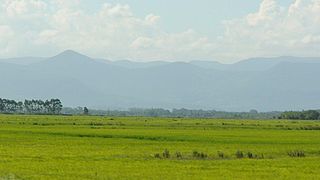The Pampas are fertile South America lowlands.
Contents
Pampa or La Pampa may also refer to:
The Pampas are fertile South America lowlands.
Pampa or La Pampa may also refer to:

The Pampas are fertile South American low grasslands that cover more than 1,200,000 square kilometres (460,000 sq mi) and include the Argentine provinces of Buenos Aires, La Pampa, Santa Fe, Entre Ríos, and Córdoba; all of Uruguay; and Brazil's southernmost state, Rio Grande do Sul. The vast plains are a natural region, interrupted only by the low Ventana and Tandil hills, near Bahía Blanca and Tandil (Argentina), with a height of 1,300 m (4,265 ft) and 500 m (1,640 ft), respectively.

The Mapuche are a group of indigenous inhabitants of south-central Chile and southwestern Argentina, including parts of Patagonia. Originally from the forests of the southern Andes, Mapuche people lived in the woods as "horticulturalists”. Mapuche populations shifted towards Argentina and Chile in the sixteenth century. The collective term refers to a wide-ranging ethnicity composed of various groups who shared a common social, religious, and economic structure, as well as a common linguistic heritage as Mapudungun speakers. Their homelands once extended from Aconcagua Valley to Chiloé Archipelago and later spread eastward to Puelmapu, a land comprising part of the Argentine pampa and Patagonia. Today the collective group makes up over 80% of the indigenous peoples in Chile, and about 9% of the total Chilean population. The Mapuche are concentrated in the Araucanía region. Many have migrated from rural areas to the cities of Santiago and Buenos Aires for economic opportunities.

Jujuy[xuˈxuj] is a province of Argentina, located in the extreme northwest of the country, at the borders with Chile and Bolivia. The only neighboring Argentine province is Salta to the east and south.

La Pampa is a sparsely populated province of Argentina, located in the Pampas in the center of the country. Neighboring provinces are from the north clockwise San Luis, Córdoba, Buenos Aires, Río Negro, Neuquén and Mendoza.

Junín is a department and region in the central highlands and westernmost Peruvian Amazon. Its capital is Huancayo.

The IA-63 Pampa is an advanced jet trainer with combat capability, produced in Argentina by Fabrica Militar de Aviones (FMA) with assistance from Dornier of Germany.

The Semi-arid Pampas, also known as the Dry Pampas, is a temperate grassland ecoregion of central Argentina.

The Humid Pampas is an extensive ecoregion of flat, fertile grassland of loessic origin in Argentina. It has a precipitation average of 900 mm per year, in contrast with the Dry Pampas to the west, which average less than 700 mm.

The Tehuelche people, also called the Aónikenk, are an indigenous people from eastern Patagonia in South America. In the 18th and 19th centuries the Tehuelche were influenced by Mapuche people, and many adopted a horseriding lifestyle. Once a nomadic people the lands of the Tehuelche were colonized in the 19th century by Argentina and Chile gradually disrupting their traditional economies. The establishment of large sheep farming estates in Patagonia was particularly detrimental to the Tehuelche. Contact with outsiders also brought in infectious diseases ushering deadly epidemics among Tehuelche tribes. Most existing members of the group currently reside the in cities and towns of Argentine Patagonia.

The Tayacaja Province is one of seven provinces located in the Huancavelica Region of Peru. The capital of this province is the city of Pampas. The province has a population of 116,371 inhabitants as of 2002.
The Ranquel or Rankülche are an indigenous tribe from the northern part of La Pampa Province, Argentina, in South America. With Puelche, Pehuenche and also Patagones from the Günün-a-Küna group origins, they were conquered by the Mapuche.

Pampa de Achala is a region that lies at the heart of the Sierras de Córdoba located within Sierras Pampeanas, and located in central-northwest of Argentina. It is a rugged area with little vegetation, lying over 1,500 m (4,900 ft) above sea level, and which has distinctive species, ecology, relief and hydrography. The region is a regional water reserve, and the source of the vast majority of streams that run through the Córdoba Province. Quebrada del Condorito National Park is in the region.
The Environment of Argentina is characterised by high biodiversity.

The Sierras Pampeanas is a geographical region of Argentina.
The Querandí were one of the Het peoples, indigenous South Americans who lived in the Pampas area of Argentina; specifically, they were the eastern Didiuhet. The name Querandí was given by the Guaraní people, as they would consume animal fat in their daily diet. Thus, Querandí means "men with fat". Prior to the 19th century, they were also known as the Pampas. Mapuche called them Puelche.
The Pampas are fertile South American lowlands.

The Desert Campaign (1833–1834) was a military campaign in Argentina led by Juan Manuel de Rosas against the indigenous people of the southern Pampas and northern Patagonia. The campaign was later followed by the Conquest of the Desert, which took place in the 1870s and 1880s.
Savage Pampas may refer to: